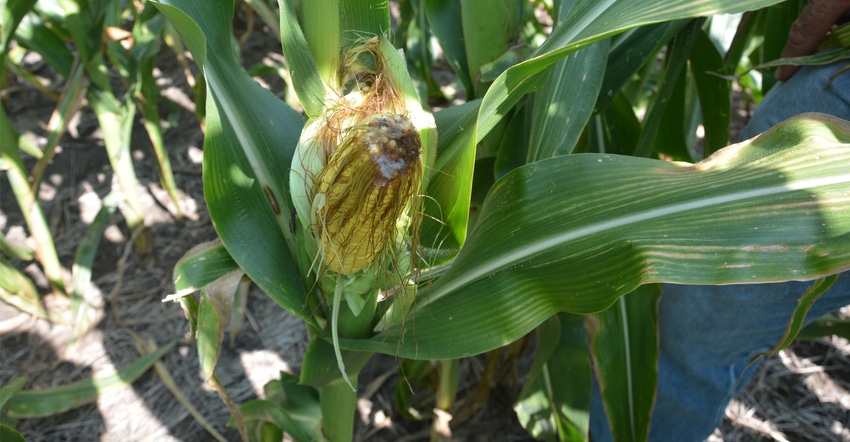
As if the challenges of the year — freeze, drought, heat, floods — weren't enough, the farmers who were lucky enough to harvest a corn crop have a new threat: mycotoxins in the corn crop.
"Normally you will see a problem with mycotoxins in the grain when there have been stresses that caused damage to the kernels and created a pathway for the fungal infections that cause the development of toxins," says Dr. Tim O'Brien, Agrisure traits manager with Syngenta.
O'Brien says aflatoxins are most likely to develop in areas where there is drought stress, such as what occurred in central and eastern Kansas this year. It is exacerbated by the kind of hot, muggy weather that followed in the weeks before harvest.
Fortunately, O'Brien says, producers who have faced problems with marketing their crop this year because of mycotoxin development can turn to science for help when they make planting decisions for the 2019 crop.
First, there are drought-tolerant or water-utilizing varieties such as Agrisure Artesian corn hybrids, which provide season-long protection from drought stresses.
Second, varieties such as those with the Agrisure Viptera trait have built-in protection from the development of fungal diseases by protecting the plant from feeding by insects.
"The Agrisure Viptera trait protects the above-ground plant from 13 insects and protects the ear from feeding," he says. "If you don't have damage, you get less mold and therefore less toxin. And if you purchase the trait in the seed you don't have to worry about the work and expense of scouting and spraying and hoping that you get weather conditions that allow you to get good control."
He says the Viptera trait comes from a naturally occurring protein that Syngenta discovered in sour milk.
"Back in the '90s, a researcher came home from vacation to a jug of sour milk," O'Brien says. "He decided to experiment with it and discovered that insects were unable to digest it. So he went to work, isolated the protein and tried introducing it in plants to see if it would protect them from insects. And it did."
For those growers this year who already have evidence of diseases such as aflatoxins, fumonisins and vomitoxins it is paramount to get the crop out of the field, dried down and cooled off, O'Brien said.
"If you can get it down to under 15% moisture and to 65 degrees F or cooler, it will stop the toxins from multiplying," he says. "You can't reverse the presence of mycotoxins already there, but you can get the grain into proper storage and prevent it from getting worse. In severe situations you can clean the grain and try to remove damaged kernels that are more likely to be infected."
That is one of the instances in which varieties such Agrisure Artesian corn hybrids and help the crop hold on longer before aborting kernels.
"Sometimes, just a matter of a few days can make a difference," O'Brien says. "If the crop can just hold on, there may be a rain in time to prevent losses. Artesian holds on longer."
Producers who have mycotoxins present in the grain face some market limitations, defined by which toxins they are.
Fumonisin is a problem for horses, and grain containing that toxin should not be sold for horse feed.
Swine are particularly sensitive to vomitoxin and, as the name suggests, vomit from eating contaminated grain.
Mycotoxins of all strains are an issue in selling corn to ethanol plants because the process of removing the starches concentrates the toxins in the distillers' grain byproducts.
"Some animals will simply refuse to eat the feed that contains toxins," O'Brien says. "That means the rate of gain in the feedlot goes down."
"O'Brien said that so far in early harvest, there have been reports of aflatoxin in Kansas, Missouri, Iowa and Oklahoma, reports of fumonisin in Missouri, Nebraska, Oklahoma and Arkansas, and reports of vomitoxin in Nebraska.
"As harvest progresses, it's something to be on the lookout for," O'Brien said. "The later harvest gets pushed, the worse the problem is likely to become in areas that already have issues."
About the Author(s)
You May Also Like




